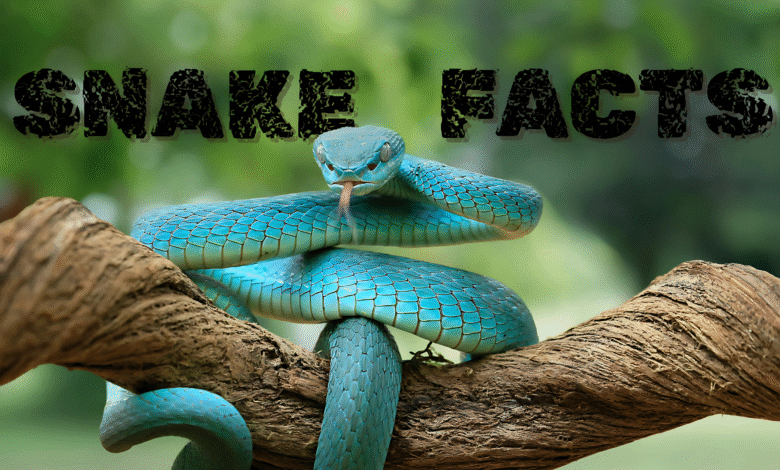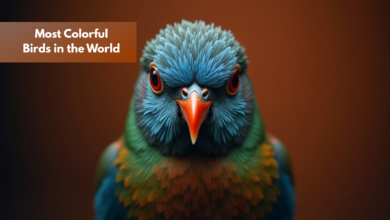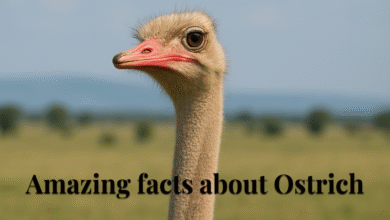
So, it’s close on the passage of most interesting creatures in the animal world. Sinuous in their bodied, and having numerous habitat ranges and incredible adaptations, reptiles have fascinated humans for thousands of years. Even if they are reviled or misunderstood in various societies, snakes are important ecologically, and exhibit a wide diversity of behaviors and survival techniques.
In this comprehensive guide, we uncover some of the most amazing snake facts—from unique species and surprising hunting techniques to the differences between venomous and non-venomous snakes. Whether you’re curious about snake habitats, adaptations, or how snakes smell without noses, you’ll discover fascinating insights into the mysterious world of snakes.
🐍 Snake Facts: What Makes Snakes So Unique?
Snakes are legless reptiles belonging to the suborder Serpentes.
There are over 4,000 species of snakes worldwide.
They are ectothermic (cold-blooded), meaning they rely on external heat sources to regulate their body temperature.
A snake’s skin is covered in scales and is shed several times a year through a process called ecdysis.
Most snakes have poor eyesight, but excellent senses of smell and vibration.
Some species can go weeks or even months without food, depending on their metabolism and diet.
Snakes are found on every continent except Antarctica.
🐍 Types of Snakes: Understanding Snake Classification
Snakes can be broadly categorized into two main types:
🐍 Venomous Snakes

These snakes are venomous and kill or paralyze their prey with their venom. Venom also aids in the prey’s internal digestion. Not all venomous snakes are dangerous to humans, but all have specialized venom glands and hollow fangs to introduce toxic enzymes into prey. Some, like cobras and vipers, can regulate how much venom they deliver. Their venom is species-specific and may include neurotoxins, hemotoxins, or both, each of which affects different areas of the prey’s body.
🐍 Non-Venomous Snakes

🐍 Venomous Snakes: The Deadliest Predators
Venomous snakes have evolved to become highly efficient predators. Their venom types vary—some cause paralysis (neurotoxic), others affect blood and tissues (hemotoxic).
- Inland Taipan (Fierce Snake)

The world’s deadliest land snake. Its venom is so powerful it can kill a human in less than an hour, but it’s extremely shy and is hardly ever seen in the wild. Originating from remote regions in the middle of Australia, the Inland Taipan favours dry climates such as clay plains. It is not dangerous although it exhibits potential danger to humans and normally avoids to have confrontation with them. It is very rare for it to bite, as it is very timid and rarely comes into contact with humans.
King Cobra (Ophiophagus hannah) –

World’s largest venomous snake; up to 18 feet long. It is endemic in forests and thick jungles of South and South-East Asia. The King Cobra is a specialized feeder in that unlike it’s cousins it feeds almost exclusively on other snakes including some venomous ones! Hooded display and deep hiss are warnings to potential threats. Despite its bad press its typically shy and will try to stay away from humans unless attacked.
- Black Mamba –

Known for its speed and potent neurotoxic venom. It is one of the fastest snakes in the world, capable of slithering at speeds up to 12 mph (20 km/h). Native to sub-Saharan Africa, the Black Mamba is feared for its aggressive defense and multiple rapid strikes when threatened. Its venom can cause paralysis and death within hours if untreated, making it one of the most dangerous snakes. Despite its reputation, it usually avoids human encounters and will flee if given the chance.
⚠️ Snakebite Fact: Though feared, most snakes are non-aggressive and bite only in self-defense. Prompt medical treatment and antivenom can prevent fatalities.
🐍 Non-Venomous Snakes: Gentle Giants and Silent Hunters
Non-venomous snakes may lack venom, but they have evolved powerful bodies and precise hunting techniques. Many use constriction—wrapping their muscular bodies around prey to suffocate it. Here are some interesting snake facts about popular non-venomous species:
Ball Python –

A favorite among reptile enthusiasts. Native to West and Central Africa, this non-venomous snake is known for its gentle temperament and manageable size, typically growing up to 3–5 feet. It gets its name from its defensive behavior of curling into a tight ball when threatened. Ball Pythons are nocturnal and primarily feed on small rodents. Their calm nature and variety of beautiful color morphs make them popular in the pet trade. They require warm, humid environments to thrive in captivity. With proper care, they can live up to 30 years or more. Despite being constrictors, they pose no threat to humans and are ideal for beginners in reptile keeping.
- Green Tree Python –

Known for its vibrant coloration and arboreal habits. Native to New Guinea, parts of Indonesia, and northern Australia, this non-venomous snake spends most of its life in trees. One of the fascinating snake facts about the Green Tree Python is its dramatic color change from juvenile to adult. Juveniles can be bright yellow, red, or orange, while adults turn a vivid green to blend into the forest canopy. They are ambush predators, using their prehensile tails to stay anchored while striking prey like small mammals, birds, or reptiles. Another interesting snake fact is their use of heat-sensing pits to locate warm-blooded prey at night. They coil over branches in a saddle-like position, a signature trait that makes them easy to identify. While not ideal for beginners, they are popular among experienced keepers due to their striking appearance and unique behaviors.
Milk Snake –

Often confused with venomous coral snakes due to similar colors. This non-venomous species is found across North, Central, and parts of South America. One of the most interesting snake facts about the milk snake is its use of Batesian mimicry—its red, black, and yellow bands closely resemble those of the deadly coral snake, helping it deter predators. A common rhyme helps distinguish them: “Red on black, friend of Jack; red on yellow, kill a fellow.” Milk snakes are constrictors and feed on small mammals, birds, eggs, and other reptiles. They are nocturnal and prefer hiding under logs, rocks, or leaf litter during the day. Another surprising snake fact is that the name “milk snake” comes from the myth that they suck milk from cows, which is entirely false. Their docile nature and beautiful patterns make them a popular choice among reptile enthusiasts.
Anaconda –

One of the strongest and heaviest snakes on the planet. Anacondas are skilled swimmers that spend most of their time in or near water. They are mainly found in South American swamps, rivers, and rainforests, particularly the Amazon Basin. The green anaconda can reach lengths of over 30 feet and weights of over 500 pounds, making it one of the most amazing snake facts. They ambush prey like fish, birds, deer, caimans, and even jaguars because they are sly hunters despite their enormous size. Constriction is how anacondas kill; they encircle their victim, suffocating it before swallowing it whole. The fact that female anacondas are much larger than males and may even eat smaller males during mating season is another fascinating fact about snakes.
🌊 Anaconda: The River Monster of South America
The green anaconda (Eunectes murinus) is (by unconfirmed reports) the heaviest non-venomous snake and one of the longest too; with a length of 30 feet and a weight of 200 kg and above (440 lbs). Anacondas are native to the Amazon Basin, and they are a semi-aquatic species, inhabiting swamps, rivers, and floodplains.
They are ambush predators, capable of taking down large prey like capybaras, caimans, and deer. Anacondas are excellent swimmers and can stay submerged for long periods with only their eyes and nostrils above water.
Fun Fact: Anacondas give birth to live young instead of laying eggs, with a single litter producing up to 40 baby snakes!
🐍 Snake Species Around the World: Diversity in Motion
With over 4,000 known species, snakes inhabit nearly every environment on Earth—except Antarctica. They range in size from the tiny thread snake (under 10 cm) to giants like the reticulated python and green anaconda. These fascinating snake facts highlight the incredible diversity and adaptability of snakes worldwide.
Snake Families:
Colubridae – The largest family, including garter snakes and rat snakes.
Elapidae – Includes highly venomous species such as cobras, kraits, mambas, and coral snakes.
Viperidae – Vipers and pit vipers like rattlesnakes, known for their heat-sensing pits.
Boidae – Boas and anacondas, powerful constrictors with remarkable strength.
Pythonidae – Pythons, large non-venomous constrictors found in Asia and Africa.
The green anaconda, part of the Boidae family, exemplifies some of the most impressive snake facts as it has adapted not only to forest and desert habitats but also to aquatic ecosystems, thriving in rivers and swamps.
🐍 Snake Habitats – Where Do Snakes Live? | Snake Facts

Snakes are incredibly adaptable and live in diverse ecosystems:
Forests – Dense canopy and ground cover provide ideal hiding spots.
Deserts – Sidewinders and horned vipers thrive in hot, dry environments.
Wetlands – Water snakes and anacondas favor rivers, swamps, and marshes.
Grasslands and Savannas – Perfect for cobras and kraits.
Mountains – Even cold-blooded snakes can survive in rocky high-altitudes.
Urban Areas – Species like rat snakes have adapted to live near humans.
They often hide in burrows, under logs, leaf litter, or in trees depending on their environment.
🐍 How Snakes Hunt: Silent and Strategic Predators
Snakes are stealthy hunters with a variety of techniques:
Ambush Predators – Stay motionless and strike at the perfect moment (e.g., vipers).
Pursuit Predators – Actively chase down prey (e.g., black mamba).
Constriction – Wrap around prey to suffocate it (e.g., boa constrictor, python).
Venom Injection – Immobilize prey using neurotoxins or hemotoxins.
After killing their prey, snakes swallow it whole, thanks to their flexible jaw structure which isn’t fused like ours. Their jaws stretch to accommodate prey much larger than their head.
🐍 Snake Adaptations: Nature’s Evolutionary Marvels
Over millions of years, snakes have evolved incredible traits that allow them to survive in hostile and varied environments:
⚙️ Key Adaptations – Interesting Snake Facts
Flexible Jaws & Skull – Let them eat animals bigger than their own head.
Forked Tongue – Gathers scent particles for directional tracking.
Jacobson’s Organ – Located in the mouth, it processes scent data.
Heat-Sensing Pits – Found in boas, pit vipers, and pythons to detect warm-blooded prey.
Camouflage – Their color and pattern help blend into surroundings.
Silent Movement – Specialized belly scales (scutes) help them slither silently.
These adaptations make snakes efficient, stealthy, and formidable hunters.
🐍 Snake facts: How Snakes Smell
Snakes smell nothing like we do. Unlike mammals, snakes lack a conventional nose. Instead, the snakes use a forked tongue to pick up particles from the air. These are passed to the Jacobson’s organ in the roof of the mouth which reads the chemical signals. This split design affords directional smell—to follow prey, mates or predators, for instance, by comparing scent intensity on each side of the tip of each tongue. It’s a great sensory adaptation that’s only found in a few animals, this “tasting the air.”
🐍 Conservation and Coexistence: Why We Must Protect Snakes
Snakes are essential for controlling pests like rodents and insects. Yet, they are often killed out of fear or ignorance. Many species are threatened by:
Habitat destruction
Illegal wildlife trade
Climate change
Urban expansion
Persecution by humans
How We Can Help:
Educate communities about the ecological role of snakes.
Support conservation projects and wildlife sanctuaries.
Avoid killing snakes unnecessarily—most are non-venomous and beneficial.
Protecting snakes is crucial for maintaining healthy ecosystems.
🐍 Conclusion: The Importance of Understanding Snake facts
Snakes are more than just mysterious slithering reptiles—they’re evolutionary marvels, skilled hunters, and important ecological players. By learning about different snake facts, their adaptations, habitats, and hunting methods, we gain a deeper appreciation for their role in the natural world.
Rather than fearing snakes, we should aim to understand and protect them. Education and awareness are the keys to peaceful coexistence with these fascinating creatures.














